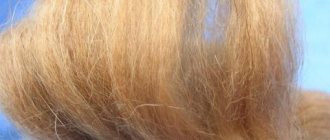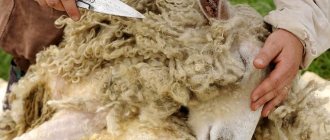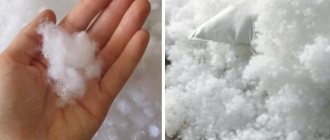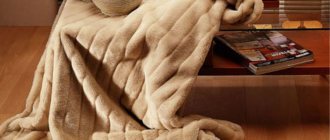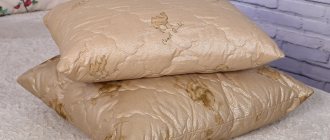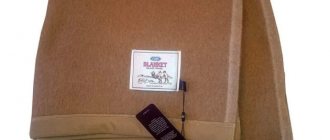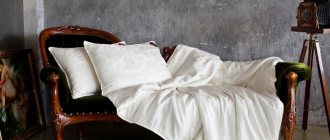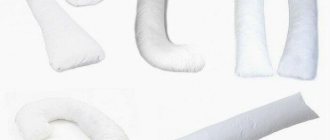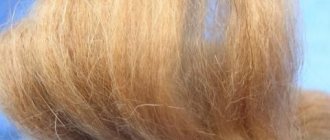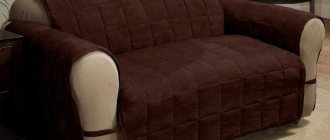In order for sleep to be deep and allow you to fully rest, several conditions must be met. Ventilate the room, regulate lighting, humidity, select a comfortable sleeping place, and, of course, choose the right blanket. The selection criteria for each person are different - thermoregulation, tactile sensations, age, and health status are taken into account. In order not to be guided only by appearance, fashion trends or price, it is better to know some of the features of each product so that there are no disappointments after the purchase.
Basic recommendations
Since in most CIS countries it is more common to use sheep wool, a camel wool blanket is bought for sleeping much less often, so you need to understand how to choose it correctly. In addition to the characteristics, advantages, and useful properties, it is important to consider some subtleties that will protect you from losing money and purchasing a low-quality product. Things to consider before purchasing:
- A camel wool blanket cannot be too cheap. (A low price may indicate that it is a fake).
- Covers should be made of natural materials.
- The quality of the seams is smooth, without protruding threads.
- No foreign odors.
- Wool processing - the higher quality it is, the softer the product. Poorly processed raw materials irritate the skin.
- Consider the seasonality; most likely, you will need different blankets for summer and winter.
On a note!
According to research, a heavy blanket helps you fall asleep faster and fall into deeper sleep. Such pressure is psychologically reminiscent of touch during hugs and stroking, and therefore causes a feeling of peace and calm. Under such conditions, the brain produces serotonin, which is converted into melatonin, which promotes deep sleep and maintains immunity.
Varieties of camel blankets
Blankets can be divided into several types - according to density and conditions of use, according to production method. For harsh winters, it is better to take a regular, denser one. For summer, there are lightweight models of lower density. For some, a universal option for all seasons is suitable. If we talk about production technology, then most often there are 2 options on the market:
- With open wool (usually thin blankets for summer evenings or for decoration). Usually very soft and tender to the touch, because they are made from the fluff of young camels.
- With closed hair. They are thicker and can be a little prickly, so they are sold in cases. They already use the wool of older camels.
In turn, closed models can also be divided according to the type of fastening inside the case:
- Quilted - the most common and inexpensive. The stitch that secures the filler is quite wide, so the wool inside can roll and get tangled over time.
- With patterned stitches - more of a decorative option, not sold so often. This type of fastening holds the contents inside more securely. At the same time, small fragments can often be knocked out through numerous holes in the seams.
- Cassette ones are the most expensive, but reliable. Diamond-shaped or rectangular stitches in the form of a geometric pattern firmly fix the wool over the entire surface, preventing lumps and delamination during use.
On a note!
Wool is used as a raw material, which is sheared or collected during molting periods. Usually this happens only once a year. The most delicate material, the undercoat or down, is combed out by hand from young camels.
Rating of the best camel blankets
Today there are a large number of foreign and domestic manufacturers who produce products from camel wool. There is a conditional rating of manufacturers, which is also taken into account when choosing. Reviews of camel wool blankets can be found on the Internet.
The woven covering makes such blankets completely scratch-free and even more practical, especially if they are filled with baby camel down.
Rating of the best camel wool blankets:
- Karakum Fleece from Dargez - due to the absence of dyes in the composition, all models are produced in a beige shade, all models are distinguished by a luxurious appearance. The option is suitable for any time of year. The material does not cause irritation, the natural fibers in the composition help to activate metabolic processes, cure joint diseases, and relax muscles.
The blanket helps maintain dry heat, which is especially important for colds. - Gobi (Mongolia) - blankets have healing properties and relieve muscle tension. Lanolin in the composition has a beneficial effect on the condition of the skin. Floral pattern, transparent bag allows you to use the blanket as a gift.
The service life exceeds several decades. - Sugar models are in fairly high demand due to their antistatic properties, strength, and lightness. Down is most often used as a raw material; such blankets are ideal for covering children and teenagers.
Pleasant to the touch, has a silky surface structure, non-prickly, comfortable for the body.
Products from Verossa, Alvitek, Ukrmetrteststandart, Aelita, Troitsk Worsted Factory, Dargez, Billerbeck are in great demand among buyers.
To be completely confident in the high quality of the products you purchase, you should carefully read the tag on the product.
Benefits of camel wool blankets
Deserts have a rather difficult climate, in which it is very hot during the day and cold at night. Camel wool is adapted to sudden temperature changes, so clothes made from it allow you to feel comfortable in winter and summer. In addition, it also has the following advantages:
- stronger than sheep, products last more than 10 years;
- has less weight compared to sheepskin products;
- relieves static tension, reducing stress levels, relaxing the body;
- Thanks to wool wax (lanolin), it has a healing effect on the scalp, joints, and muscles. Promotes rejuvenation and removal of toxins.
Ease
The camel wool pile is hollow inside, so the total weight of the product is less than analogues made from other types of raw materials. In terms of weight, sheepskin is approximately 2 times heavier. The mass varies depending on the density; the higher it is, the more grams it contains. For those who are very cold and for winter it is better to choose a density of 420 g/m², the weight ranges from 3-4.5 kg, depending on the size. A universal option for all seasons - from 300 to 350 g/m², weighs about 2-3.5 kg. In warm rooms, even in winter, 220-260 g/m² will be sufficient. And for spring and summer, 145-200 g/m² is enough, by weight this is approximately from 1 to 1.8 kg.
Thermoregulation and hygroscopicity
The low thermal conductivity of wool, due to the natural conditions in which camels live, allows you to maintain a comfortable temperature regardless of the time of year and the weather outside the window. High ability to absorb moisture helps you stay warm in cold weather, but not sweat even in the hottest weather.
Durability, wear resistance
A quality product can easily last up to 30 years, passing from generation to generation. On average, from 7 to 15 years, depending on the density and raw materials used. In order to extend the life of a blanket, it is necessary to properly care for it, periodically cleaning and airing it. And so that over time it does not look old-fashioned, it is better to choose neutral colors and patterns.
On a note!
If you store without a cover, do not ventilate, or maintain high humidity in the room, there is a high probability of dust mites and moths appearing. All this significantly reduces the service life.
Elasticity
Due to the elasticity of the fibers, even after washing and cleaning, the blanket will not roll or bunch up, forming shapeless lumps. During long-term storage it does not cake, retaining its shape for decades.
Neutrality
Every day we are exposed to static electricity and electromagnetic rays. Camel hair neutralizes dangerous charges, allowing you to relieve voltage and reduce the negative impact of surrounding electrical appliances. In addition, other blanket fillings that are not capable of eliminating static more actively attract dust, which can cause illness and allergic reactions.
The ability to “breathe”, health benefits
Thanks to the cavity of the pile, the blankets are not only light but also “airy”, that is, they conduct air well without creating a greenhouse effect. Circulation occurs in both directions, which is why they warm perfectly, but allow you not to sweat when warming up.
It is also important for many that, in addition to warmth and comfort, such things bring many health benefits to our lives. Benefits include:
- improved blood circulation, which has a beneficial effect on tissue nutrition and metabolism;
- weakening the effect of toxins on the body;
- increasing bone elasticity with a further rejuvenating effect;
- removal of inflammatory processes;
- relief of pain syndromes in osteochondrosis, rheumatitis, arthritis, radiculitis;
- soothes nervous itching, regulating the functioning of the nervous system;
- accelerates the healing process for colds and sinusitis.
On a note!
For those who suffer from excessive sweating, such blankets help cope with heat rash. Recommended for people who have sensitive skin prone to irritation.
How to choose a camel wool blanket
When choosing a product, it is important to study the main characteristics, as well as the positive and negative qualities encountered during operation. Additionally, pay attention to the methods of care, because buying a blanket, the care of which will cause great difficulties, is only worth weighing all the pros and cons.
pros
- Thermoregulation.
Camel wool has exceptional heat-regulating properties.
The camel's habitat is characterized by huge temperature changes, so its wool is unique and does not lose this property in a blanket - in cold weather it warms and retains heat, and in hot weather it protects from overheating and gives off the necessary coolness.
- Breathability.
Due to their structure, the products allow air to pass through perfectly, have “breathable” properties and provide good air exchange.
- Wear resistance.
It is believed that the average service life of these blankets is 7-9 years. However, this is a minimum; there are families in which they serve for decades, passed down from generation to generation.
- Hygroscopicity.
During a night's sleep, we release about half a liter of moisture. Therefore, it is necessary that the bedding absorbs it while remaining dry. Camel fabric can absorb up to 30% of its own weight in moisture.
- Ease.
Each fiber is hollow inside, making it very light.
For example, the weight of a woven blanket (plaid) measuring 180x200 cm is only 1300 grams. , quilted all-season blanket 170x200 cm – 2000 g. For comparison, similar products made from sheep wool will weigh 2600 and 4000 grams. respectively.
- Healing properties.
Therapeutic effect
- enhances tissue nutrition, improves metabolism;
- neutralizes toxins produced by the body;
- has a rejuvenating effect on the skin, increases skin firmness and elasticity;
- helps relieve inflammatory processes in the body;
- protects against the effects of electromagnetic fields;
- helps relieve pain from arthritis, radiculitis and osteochondrosis;
- improves the functioning of the circulatory system, enhancing blood microcirculation.
Minuses
- May cause allergic reactions.
There is information that camel wool is hypoallergenic. This is not entirely true. An allergic reaction to the wool itself is quite rare. But the lanolin contained in it is an allergen. It is also loved by various microorganisms, whose waste products can cause a reaction.
In addition, you may have an allergic reaction to the chemicals used in dry cleaning.
So people prone to allergies or suffering from bronchial asthma should use these products with great caution. A lightweight holofiber blanket, which is considered safe even for people with bronchial asthma, may be suitable. But it is advisable to abandon the Scottish wool blanket.
- Quite difficult to care for.
If washing is allowed, hand washing is preferable; it requires the use of special products. Must be protected from moths.
- High price.
However, with proper care, this disadvantage is compensated by the practicality and durability of the blanket.
Flaws
If you analyze the pros and cons, then there are much more advantages, although it is worth considering the disadvantages that are important to know before purchasing. What can be considered as disadvantages:
- Possibility of allergies (asthmatics, and approximately 1% of the population at risk).
- Not suitable for those who already have an allergic reaction to wool.
- The likelihood of dust mites appearing (to combat it, you may have to dry clean it).
- High price.
- High maintenance requirements (not all blankets can be washed).
- Modest selection of colors (hard to paint, so the palette contains only natural shades).
- A “tidbit” for moths (you should pay attention to storage conditions and avoid high humidity).
On a note!
Perhaps the main advantage is naturalness and environmental friendliness! The products do not contain synthetic additives or dyes, and their appearance remains attractive for several decades.
Camel down - the filler of the future
A down jacket and coat are indispensable elements of a woman's winter and mid-season wardrobe, which should be not only comfortable and warm, but also stylish. Such outerwear has less volume compared to classic down jackets and coats, but at the same time it is lighter and no less warm, which can be felt already during the first fitting. Appreciate all the benefits of outerwear made from camel wool - and you will never wear your old coat again.
General information
The down and wool of the Mongolian Bactrian are the highest quality raw materials for the manufacture of outerwear, but the best filler is still considered to be the warm down of the inner layer of wool, called the undercoat. Shades of woolen products vary from exquisite brown to delicate milky, but only light tones are considered truly fashionable.
The public appreciated the new product in the form of camel down filling , because natural fibers have many advantages:
- wool makes outerwear less bulky and lighter at the same time;
- the body in such products does not freeze or sweat;
- clothing partially neutralizes the adverse effects of the environment on the body;
- camel down helps get rid of the symptoms of many diseases, including colds;
- the woolen product practically does not get dirty.
It is not surprising that a women's camel wool coat has become perhaps the most popular item of warm clothing in recent seasons. Fashionistas have finally found a compromise between style and comfort, and the quality has been tested for three seasons already.
Numerous reviews of wool coats leave no doubt about the excellent thermal properties of this natural material. In addition, Bactrian fluff not only maintains body temperature and accumulates heat, but also helps get rid of many diseases, regulates sweating, has hypoallergenic properties, repels dust and protects against electromagnetic radiation.
Features of caring for a wool blanket
First of all, it is worth remembering that this is wool, which initially requires delicate care. The possibility of washing should be looked at on the label when purchasing or checked with the seller. If there is no such icon, then only dry cleaning, airing or dry cleaning will do. To keep contamination to a minimum, it is better to use duvet covers and change them regularly. To prevent the appearance of parasites (ticks, moths), it is advisable to shake it once every 3 months and hang it in fresh air for ventilation. If stains appear, you can use special products with lanolin, which remove dirt with the help of foam. If washing is possible, it is better to choose the manual mode; thicker, baby or small blankets can be cleaned in the washing machine.
Rules for caring for a down jacket
It is recommended to wash outerwear lined with camel wool in water no higher than 30 0C with detergents intended for washing woolen products. Or you can use a special shampoo with lanolin. The down jacket should not be spun in a centrifuge, nor should it be dried in direct sunlight. It is also not recommended to hang it on a trempel immediately after washing.
Lay the still damp down jacket on a flat surface with absorbent material on it (sheet, towel, piece of cotton fabric) and wait until it dries. Next, hang it in a cool, ventilated area away from the central heating system.
Ventilation in the open air is preferable, especially in humid weather. The camel hair insulation in a down jacket (reviews note this as another advantage) is quite easy to care for and maintain if you follow the manufacturer's recommendations indicated on a special label upon purchase. Save this information and refer to it regularly when planning cleaning or maintenance procedures for the product.
A camel wool down jacket will become a practical and high-quality addition to your wardrobe, and the carefully selected design and style of the product will lift your spirits throughout the winter season.
Review of children's sizes
Children's products always require increased attention, because the issue of safety and high quality becomes paramount. The child’s body is most susceptible to the influence of synthetics and raw materials that are harmful to health, so parents try to choose a safe option, even despite the high price. Blankets and blankets made of camel down or wool have hypoallergenic properties, are not subject to shedding, do not cause irritation, and do not become “dust collectors.” Manufacturers offer several options:
- 1 m x 1.35 m;
- 1 m x 1.40 m;
- 1 m x 1.50 m;
- 1.1 m x 1.40 m.
The sizes are chosen taking into account the age, body shape of the child, the dimensions of the crib, sometimes they take a little more so that it can be used for several more years.
Advantages of camel wool
To make home textiles, camels use a coat consisting of coarse hair and undercoat. Nowadays, coarse hair is practically not used, since the undercoat (also called fluff) is more valuable and during the combing period (and this is usually done once a year), from an adult animal you can get from 4 to 9 kg of material.
The most valuable are the down of the Mongolian Bactrian and the down from the breasts of young camels.
The main advantage of camel wool is that it provides so-called “dry heat”:
- Warm, with constant wear it maintains a constant body temperature;
- Absorbs moisture perfectly, but does not retain it, but quickly evaporates;
- Does not absorb unpleasant odors;
- Light and thin;
- Does not accumulate static electricity;
- Has healing properties.
Among the latter: improved metabolism, anti-inflammatory effect. Camel down is useful for joint diseases, and thanks to its lanolin content, it increases the firmness and elasticity of the skin.
However, there are also disadvantages: high price. fluff is contraindicated for allergy sufferers. There are difficulties in caring for: although a real thing made of camel wool is difficult to get dirty, it cannot be washed at home, but must be immediately taken to dry cleaning.
Also, when buying socks, you need to understand that they will dry out very quickly. But a coat that doesn't rub against anything can last for years.
Types of fabrics for quilted covers
Manufacturers use various raw materials as filler - the undercoat (down) of camels and small camels (combed by hand), and wool, which is sheared and collected during molting periods. More delicate material is used in open form; it is used for blankets, pillows, shawls, stoles, hats, mittens, socks, clothing, and also as additives for the workwear of divers, polar explorers, and astronauts. For closed quilted products, they take what they get after shearing older individuals; this is more prickly and stiff wool, so it is hidden in covers. A variety of materials for covers allows you to choose the most attractive option in terms of tactile sensations, price and color.
Batiste is a summer version made of light, almost airy linen or cotton fabric. Very soft, translucent breathable material.
Satin is also better suited for summer or for those who love the smooth texture of silk fabrics. Silk or cotton in the composition make this fabric glossy and very pleasant to the touch. Additionally, it creates a cool effect due to its texture. In addition to its appearance, it is very practical to use - it is resistant to frequent washing and fading.
Calico is inexpensive and will last a long time. Lightweight, durable, easy to wash and almost wrinkle-free. The main composition is cotton.
Teak is a canvas or twill made from cotton and linen. Dense material with variegated stripes. In addition to covers, it is used for mattresses and curtains.
Percale is a cotton fabric in which no twisted threads are added, due to which it has increased strength. The fillers do not come out through it, remaining always inside. Typically used in natural shades because it is not dyed during production. To understand more about its strength, it is worth mentioning that it is also used to make parachutes.
Twill (kipper) is a twill weave of cotton with a rib. This fabric is more suitable for winter blankets. It is quite rough to the touch, so for such covers it is recommended to additionally use a duvet cover.
Most often they use colors in soft pastel colors, with floral or geometric prints. For children, drawings of fairy-tale characters or soft toys are usually applied.
On a note!
Before purchasing, you must carefully inspect the seams to ensure they are even and without loose threads. A good sign of quality is the presence of bias tape around the perimeter, which allows you to maintain its shape without changes.
Choosing a manufacturer
When choosing a camel wool blanket, “which company is better?” - one of the most common questions that arise from buyers. It is worth knowing that there are not many good manufacturers, so it is worth asking where they get their materials. The main countries that supply raw materials in which camels are bred for industrial purposes are Mongolia, Kazakhstan, and China.
Russian manufacturers
AlViTek is a factory located in the Moscow region. It produces both a winter version and lightweight models for summer. The main products are quilts.
“Dargez” is an association that creates airy quilts for adults and children. These are several factories across the country that produce home textiles and have a wide range of related products.
“Aelita” is a company from Ivanovo, the main emphasis is on quilted universal and lightweight models. Natural textile covers are used.
"Runo" are representatives of the premium segment. Their plain woven blankets in natural shades made from fine wool and down are extremely popular. The most famous brand of products is “Karakum”.
“Lezheboka” - they use raw materials from Mongolia, which are sold under the brand name “Tailak”. They specialize in universal quilted models for all seasons.
Foreign - Mongolian company, a leader in quality products with a worldwide reputation. Considered one of the best. It is in an advantageous position because production is located in the same country as the raw materials. Reasonable prices, excellent appearance of finished products, they use only 100% camel wool without any admixtures of synthetics and other natural materials.
Billerbeck is a German manufacturer with almost a hundred years of history. One of the first to enter the Russian-speaking market, it is positioned as a supplier of high-quality and practical products. Constantly engaged in research and improvement. Some of their innovations in the field of sleep can be considered revolutionary.
On a note!
There are many more sellers, so always read the labels carefully, take an interest in reviews and comments from customers who have already purchased products in the selected stores.
Review of manufacturers and brands
On sale are both imported, mainly Mongolian, products and domestic ones, represented by several leading factories. GOBI - woven blankets made from Mongolian camel wool, considered one of the best. The brand is known not only here, but throughout the world; their blankets combine high quality, decent appearance and a very reasonable price. These are completely natural products made from 100% camel raw materials without the admixture of synthetics and merino.
- AlViTek - a domestic factory from the Moscow region, which has launched the production of quilts made from camel down in both warm and lightweight varieties.
Manufacturers also called one of the product lines GOBI, so when buying a blanket under this brand, look where it was made.
- Ivanovo company Aelita – production and sale of quilts made of camel wool, a range of lightweight, regular and thick products.
Cotton fabrics are used for covers in camel wool blankets. - Trinity Worsted Factory - specializes in woven blankets made of camel wool and down, delicate, soft and light, but no less warm, the most famous creations are their brands “Karakum”, wool and “Sahara”, down.
- Fleece is another popular Russian brand that produces high-quality products from camel wool and down, and woven blankets. The “Karakum” brand, made by them, is an elite plain blanket in natural tones.
- Dargez is a large concern that unites production facilities throughout the country, focused on home textiles. One of the directions is the production of quilts made from camel hair and down. The collection for adults is “Sahara”, for kids – “Camel”.
- Couch potato – our manufacturer of products made from Mongolian baby camel fluff under the Tailak brand.
These are all-season quilts.
Products differ in their decorative component, manufacturing method, raw material base and cost, but regardless of the brand, natural camel blankets retain all their properties.
Price
The price for quality camel wool products cannot be too low. No discounts or promotions will reduce the cost so much that it raises suspicions of authenticity. Raw materials do not deteriorate so quickly over time, so these products will always be in price. If we talk about the order of prices, then for full-fledged adult models it should not be less than 1,500 rubles. This price tag is only acceptable for children's sizes. Blankets for all seasons for a single bed are available from 4,000 to 7,000 rubles. from a domestic manufacturer, foreign companies will ask for more than 10,000 rubles for the same. Elite products cost from 11,000 rubles.
Reviews
Anna, Nizhnevartovsk
We bought it a few years ago for our daughter. Our winters are harsh, the apartment is not always comfortable, even the boiler does not always help. Chosen for safety, lightness and appearance. It warms better than a stove; it can’t even be compared with synthetics like padding polyester. Bought it to grow, still like new.
Olga, Saratov
Since childhood, I remember my grandmother’s blanket; I have warm memories of the holidays and the warmth from it. Then it seemed very prickly, but it was light and warm. Recently we decided to replace an old blanket with padding polyester; I wanted to know if there were any analogues similar to what we had in childhood. I was surprised by the variety and quality of modern goods. I bought it without much hesitation, I know for sure that it will not be demolished!

